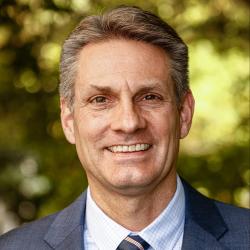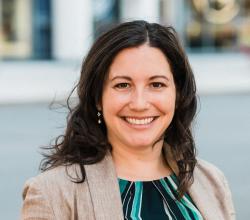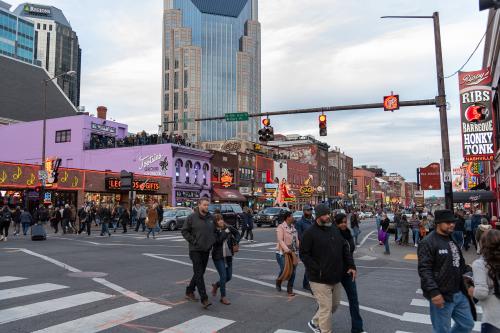This post was updated on December 16, 2022 with a correction for Figure 1.
As the COVID-19 economic and public health emergencies slowly abate, local leaders nationwide are adjusting to a reality in which—at least in the short term—they have significant resources to address both acute and long-standing challenges. Many of those resources are flowing to cities and counties via the American Rescue Plan Act’s (ARPA) flexible State and Local Fiscal Recovery Funds (SLFRF).
Our three organizations—the National League of Cities, the National Association of Counties, and Brookings Metro—are tracking how cities and counties are using these flexible funds via our Local Government ARPA Investment Tracker. The latest data, which jurisdictions submitted to the Treasury Department for activity through December 31, 2021, reflects decisions that cities and counties made in the seven months after receiving their first tranche of SLFRF dollars. This data comes from 89 cities and 240 counties that have at least 250,000 residents; they are required to make frequent reports to Treasury on how they are deploying the funds.
ARPA permits SLFRF recipients to use the dollars to address a wide range of needs in response to the pandemic and its impacts. As of the end of 2021, those 329 jurisdictions had identified more than 4,500 discrete projects for which they had budgeted at least a portion of their flexible funds. Our organizations analyzed the project data, including (as we described in February 2022) “coding” each project into one of seven overall spending groups (community aid; economic and workforce development; government operations; housing; infrastructure; public health; and public safety), and then into 41 spending sub-groups that provide further detail on the use of the funds. In this piece, we identify four key takeaways about city and county priorities from the new data.
Large counties and cities had budgeted 41% of their total SLFRF funds, or 82% of their in-hand first tranche funds, by the end of 2021
Altogether, the 329 large cities and counties are receiving $62.0 billion in SLFRF dollars in two roughly equal tranches, distributed in May 2021 and May 2022. As of December 31, 2021, they had budgeted a combined $25.3 billion. That represented roughly 41% of their total allocation, or 82% of their available first-tranche funds. Budgeted funds are those that cities and counties have expressly set aside through legislative appropriations or similar local processes for eligible projects they identify in reports to Treasury.

With 40% of SLFRF dollars committed, large cities and counties are collectively where we might have expected them to be at the end of 2021. They had many urgent economic, fiscal, and public health needs to address with their first tranche of funding. At the same time, many were awaiting the final SLFRF regulations to determine how they would be able to allocate the funds; Treasury published that final rule in January 2022.
Cities were a bit faster to budget their SLFRF dollars than counties. The 89 cities combined had budgeted $14.5 billion by the end of last year, or 55% of their total allocation. That reflects in part the outsized influence of New York City, which had committed its full $5.9 billion allocation; excluding New York, the other 86 cities had budgeted 42% of their combined SLFRF dollars. The 240 counties, by contrast, had budgeted 30% of their combined allocation by December 31. This suggests that many counties were taking a more conservative approach, or had more complex processes to formally approve the use of SLFRF dollars than cities.
Actual expenditures on cities’ and counties’ budgeted projects as of December 31 represented 10% of their total SLFRF allocations, or 20% of their available first-tranche funds. Again, given the budgetary and procurement processes local governments must follow, this rate is not surprising. Foreseeing this, Congress gave SLFRF recipients through 2026 to fully expend their allocations.
Government operations accounted for the largest share of cities’ and counties’ budgeted ARPA funds
Congress and the Biden-Harris administration argued for ARPA to support state and local governments in part to prevent a reoccurrence of the Great Recession’s aftermath, when state and local employment never fully rebounded from the deep cuts it sustained. ARPA and the rule implementing SLFRF thus provide local governments with wide latitude to spend the dollars to rehire employees laid off due to the pandemic, provide them with back or premium pay, hire additional employees to help administer SLFRF dollars, and invest in facilities and systems that help government do its work in a post-pandemic world. Cities and counties can also use their allocation for “revenue replacement”—essentially, contributions to the local general fund, in accordance with the amount of revenue they were estimated to have lost due to the pandemic.
We classify these projects together as “government operations,” and large cities and counties budgeted a combined $10.7 billion toward them through the end of 2021, or 42% of their total budgeted SLFRF dollars ($25.3 billion). Government operations was the single largest use of budgeted dollars for both cities and counties, accounting for 50% of budgeted funds in cities and 32% of budgeted funds in counties.

Cities, for their part, made liberal use of the revenue replacement provisions, designating $5.5 billion to the “fiscal health recovery” spending sub-group. Many large cities, including Buffalo, N.Y., Houston, New Orleans, Pittsburgh, San Antonio, San Diego, and San Francisco budgeted at least $100 million for this purpose. Chicago alone dedicated $1.3 billion of its $1.9 billion allocation to fiscal health recovery. That noted, about half of cities also budgeted SLFRF dollars toward government employee wages or hiring.
Counties designated a combined $1.3 billion of their budgeted SLFRF dollars to fiscal health recovery, and another $1 billion toward their employees. They invested more significantly than cities in facilities, equipment, and IT, with more than 300 discrete budgeted projects in this area totaling more than $750 million. Many of these were capital investments to promote public health, such as upgrading ventilation systems in county buildings to prevent the spread of COVID-19. Others assisted disproportionately impacted communities, such as upgrades to shelters for domestic violence victims or early-education centers.
Beyond government operations, large cities and counties spread their budgeted ARPA dollars fairly evenly across other priorities
Our Local Government ARPA Investment Tracker examines six major spending categories in addition to government operations. As of the end of 2021, large cities and counties had spread their budgeted SLFRF dollars widely across these categories: 14% to public health; 12% to infrastructure; 9% to economic and workforce development; 9% to housing; 8% to community aid; and 6% to public safety. In this way, local governments seemed to be taking advantage of the flexible and significant ARPA resources to address a range of locally determined needs.
There were some notable distinctions between county and city uses of the funds. Counties, which typically operate local public health systems, dedicated a considerably larger share of their budgeted ARPA funds toward public health (20%) than cities (9%). Counties also budgeted a larger share toward infrastructure (14%) than cities (10%), with sewer and water systems accounting for the bulk of their budgeted infrastructure spending, followed by broadband. Cities spent a somewhat higher share of their ARPA funds on public safety (7%) than counties (4%)—investing most significantly in police department capacity as well as violence reduction/prevention strategies.

While cities and counties differed somewhat in their SLFRF budget priorities, Covid-related public health projects were the most common type of project investment for both types of jurisdictions through the end of 2021. Both cities (143 projects) and counties (505 projects) used ARPA dollars to support strategies such as vaccination and testing sites, public health communications, and financial incentives for residents and employees to get vaccinated. Indeed, a number of counties and smaller cities that had yet to budget much of their allocations nonetheless set aside dollars for urgent pandemic-related health responses.
One additional noteworthy pattern across cities and counties: The larger the allocation a jurisdiction received, the more diverse the set of priorities they sought to address. The average city or county that received more than $250 million in SLFRF dollars budgeted funds across 10 detailed spending categories (out of 40 total), compared to six categories for those receiving between $100 million and $250 million, and five categories for those receiving less than $100 million. This suggests that the budgeting process in most communities led them to address more—and more diverse—priorities with larger SLFRF grants, rather than using the dollars to address one or two large challenges at scale.
City and county spending priorities are continuing to evolve
Overall, through the end of 2021, America’s large cities and counties made significant progress toward deploying their flexible ARPA allocations. They addressed exigent needs—particularly around restoring critical government services and ramping up public health responses—while navigating local budgeting processes and some uncertainty about the final rules for the SLFRF program. And they used the flexible program to begin to address a variety of locally specific needs.
Still, there were many jurisdictions, particularly counties, that had budgeted only a small share of their allocations through the end of 2021. That has likely shifted in intervening months, with more places budgeting and obligating SLFRF-supported projects. Some jurisdictions had already formally approved broad spending priorities in 2021 (e.g., Detroit and Cook County, Ill.), but had not yet selected specific projects to implement those priorities. And several places remained engaged in robust community engagement efforts to ensure residents’ priorities were considered in budgetary decisions. Others have been coordinating with their states on priority projects or closing out response projects funded by the CARES Act of 2020. The pace of spending commitments in any given community likely reflects a mix of economic, fiscal, political, and cultural conditions and norms.
With many places having addressed acute needs with the first round of ARPA funds, cities and counties may now have the opportunity to consider more strategic, scaled strategies with their remaining flexible funds. They could do more to align their SLFRF-supported projects with those in surrounding jurisdictions—for example, Minneapolis’ collaboration with Hennepin County, Minn. on public health upgrades to its emergency homeless shelters, or Seattle’s partnership with King County, Wash. to provide training to hospitality workers of color negatively impacted by the pandemic. They can also use SLFRF dollars to guide how funding from the Infrastructure Investment and Jobs Act (IIJA) could land in their communities, as counties such as Frederick, Md., Pierce, Wash., and Seminole, Fla. are doing with respect to broadband infrastructure.
Overall, the latest available data confirms that cities and counties have used flexible American Rescue Plan dollars to tackle many acute, pandemic-related challenges. It also reveals that local leaders still have significant scope to address some of the deeper structural issues that exacerbated the impacts of the COVID-19 crisis on disadvantaged populations and communities.





Commentary
How cities and counties are putting American Rescue Plan dollars to work
July 12, 2022